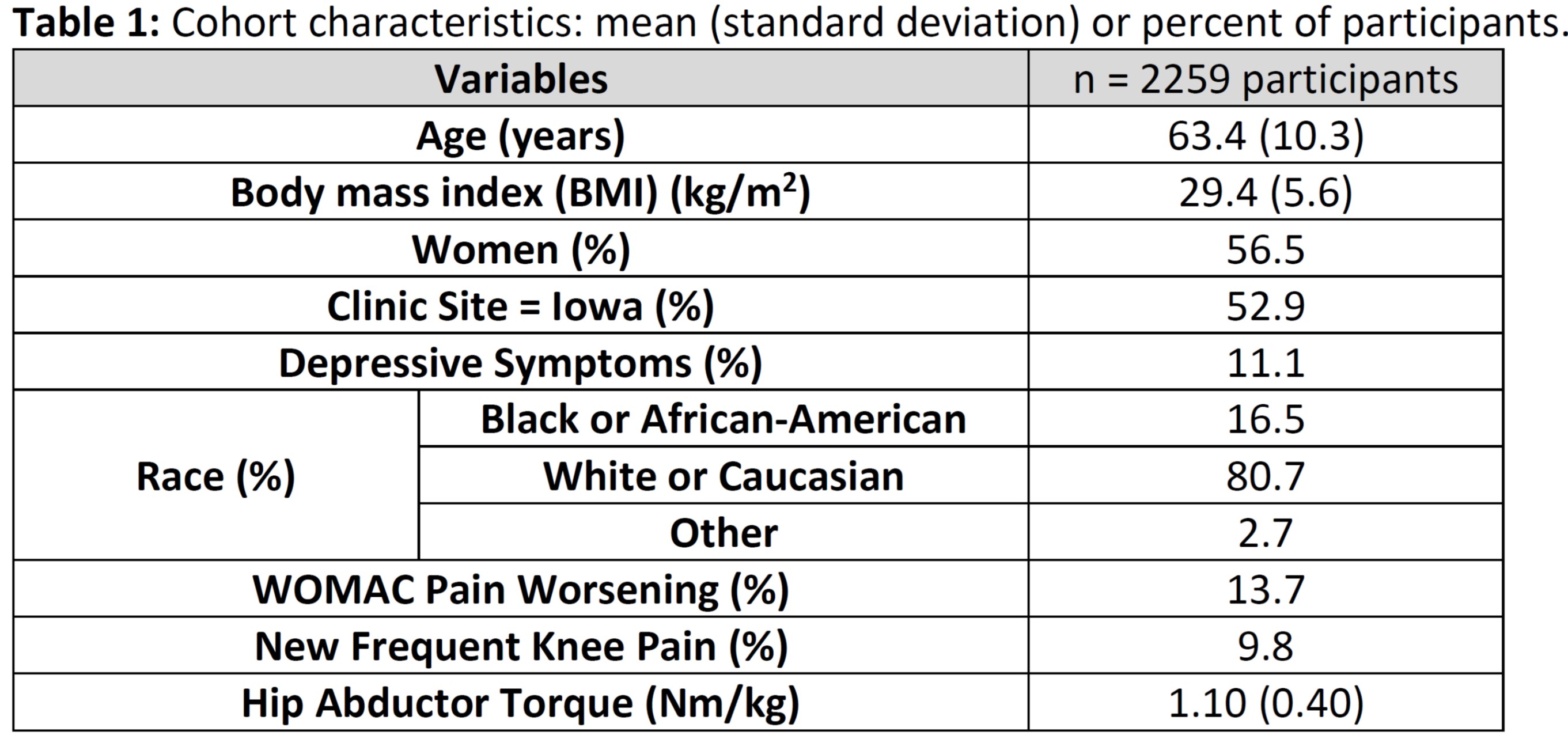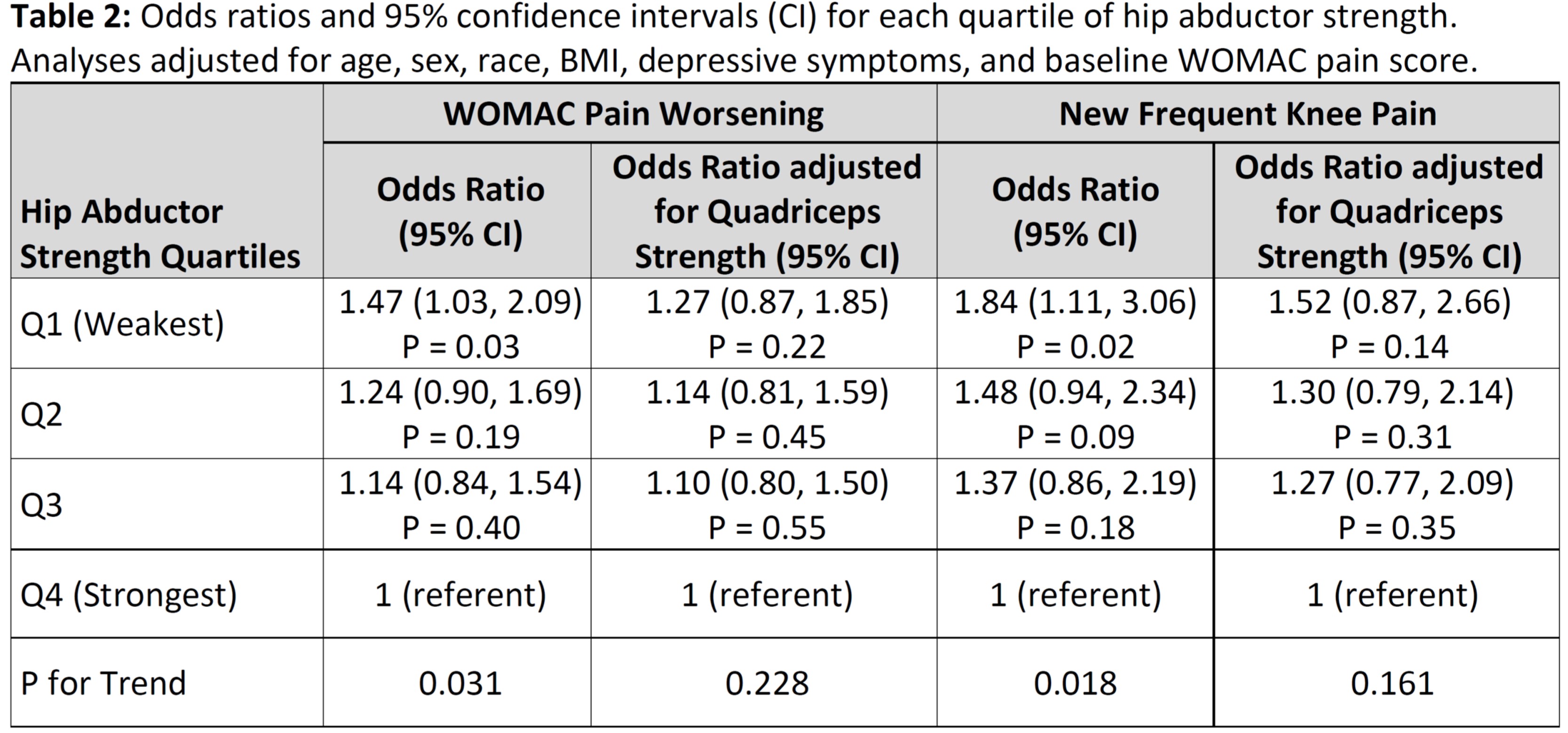Session Information
Date: Saturday, November 7, 2020
Title: Epidemiology & Public Health Poster II: OA, Osteoporosis, & Other Rheumatic Disease
Session Type: Poster Session B
Session Time: 9:00AM-11:00AM
Background/Purpose: Hip abductors are important for controlling pelvic orientation and rotation of the femur during gait, both of which affect knee mechanics. Thus hip abductor weakness may influence the development or worsening of knee pain. The purpose of this study was to evaluate the relation of hip abductor strength to worsening or new onset of frequent knee pain, with and without adjusting for quadriceps strength.
Methods: We used data from the Multicenter Osteoarthritis Study (MOST). For the existing cohort, the 144-month study visit was considered baseline for the current analysis. At this visit, a new cohort was recruited, with their initial visit considered as the baseline. Participants had hip abductor and quadriceps muscle strength measured in each limb. Strength was measured as maximal isometric torque with hip abduction and isotonic torque with knee extension, respectively. Sex-specific quartiles were created for both hip and knee strength. Participants also filled out the WOMAC questionnaire and answered questions about frequent knee pain at baseline, 8, 16 and 24 months later.
We characterized two knee pain outcomes. First, using the WOMAC questionnaire, we defined worsening as an increase in pain score by at least 2 on the 0-20 scale. We characterized each knee as having worsening pain if worse pain was reported at 2 or more of the 3 follow-ups. For those who did not report frequent knee pain (FKP) at baseline, we characterized the knee as having new FKP if they responded ‘yes’ to the frequent knee pain question at greater than 50% of 2 or more follow-ups. Non-cases were those with no reports of worsening or new FKP on follow-up. We carried out hip and knee specific analyses testing hip abductor strength as a risk factor for ipsilateral worsening and new knee pain, accounting for the correlation between limbs with GEE and adjusting for age, sex, race, body mass index (BMI), depressive symptoms, and baseline WOMAC pain score in that knee. After initial analyses, we added quadriceps strength as a covariate.
Results: Of 2391 participants with hip abductor strength measurements, sufficient follow-up data were available from 2259 participants for WOMAC pain worsening and 1891 participants for incident frequent knee pain. Characteristics of the participants are in Table 1. In analyses unadjusted for quadriceps strength, hip abductor strength demonstrated a significant association with worsening WOMAC knee pain and new onset FKP (Table 2). However, when we adjusted additionally for quadriceps strength, the associations between hip abductor strength and knee pain became much weaker and nonsignificant. Quadriceps strength was associated with pain outcomes; trend tests were significant for WOMAC pain worsening (p=0.023) and for new onset frequent knee pain (p=0.038).
Conclusion: Hip abductor strength is not independently associated with worsening or incident knee pain in this cohort. Instead, the relation of abductor strength with knee pain appears to be substantially due to its association with quadriceps strength.
To cite this abstract in AMA style:
Lewis C, Segal N, Stefanik J, Chen X, Williams G, Nevitt M, Lewis C, Felson D. Hip Abductor Strength and Its Association with New or Worsening Knee Pain: The MOST Study [abstract]. Arthritis Rheumatol. 2020; 72 (suppl 10). https://acrabstracts.org/abstract/hip-abductor-strength-and-its-association-with-new-or-worsening-knee-pain-the-most-study/. Accessed .« Back to ACR Convergence 2020
ACR Meeting Abstracts - https://acrabstracts.org/abstract/hip-abductor-strength-and-its-association-with-new-or-worsening-knee-pain-the-most-study/


